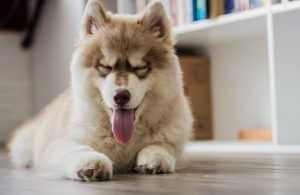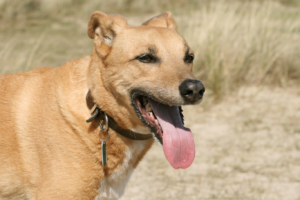
Many dogs scarf down anything placed in front of them, so you may be wondering why your dog sniffs their food and walks away.
As loving dog owners, this can be tough to watch and may cause you to worry.
Let’s break down what could be affecting your dog’s ability or willingness to eat and what you can do to coax them into eating again.
Why Won’t My Dog Eat?
Dogs refuse to eat for many different reasons ranging from their dislike of the food to medical conditions to changes in their environment.
Medical Conditions
Before anything else, it’s important to rule out any potential medical conditions that may be causing your dog to be disinterested in their food.
If your dog is sick, they may not feel like eating. Just like us, having a virus can make them lose their appetite entirely. So if your dog has recently shown signs of illness, like vomiting or diarrhea, we recommend reaching out to your vet to treat the root problem.
Another culprit could be a recent change in medication. Certain medications and antibiotics can cause nausea or stomach aches. Speak with your vet about any recent changes to your dog’s medical treatment to see if those changes could be affecting their willingness to eat.
Anxiety
Much like us, anxiety can cause our dogs to have upset stomachs and they may avoid food as a result.
Consider any recent changes to your dog’s environment. Have you moved homes recently? Have you been spending a lot more time at home or been out of the house more recently? Have you personally been undergoing a lot of additional stress? Dogs are highly empathetic creatures and will pick up on their owner’s stress. If you’ve been feeling stressed out, your dog may be feeling more anxious too.
Take a moment to assess any recent changes in your dog’s life and see if they line up with a recent change in their eating habits. Try to make them feel less anxious about the change by reducing your own stress, getting them back into a normal routine, or spending more quality time with them. They’ll likely return back to their normal eating habits once they’re sure everything is a-okay!
Food-related Issues
Many dogs have food allergies or sensitivities, which can cause them to be reluctant to eat. If this is the case, try switching their food to a tastier, human-grade quality dog food option with no artificial ingredients or preservatives. If this doesn’t work, you should consult with your vet or a vet nutritionist to try to determine if there are particular foods that your dog may be allergic to.
Smell and taste are also key factors in the enjoyment of eating. Our freshly-cooked meals are perfect for dogs with sensitive stomachs, as well as picky eaters, since texture and flavor are both appealing and easy on the stomach. Many dogs dislike dry, hard kibble which oftentimes lacks moisture, nutrition, and flavor.
Consider switching out your current dog food for something that is well balanced, and does not contain artificial ingredients or preservatives. Try to avoid dog foods that contain rendered meats or by-products, as these ingredients can irritate a dog’s stomach. Your dog may change their tune when offered a more palatable meal that contains the essential nutrients they need to feel nourished and energetic!
Timing Is Everything
Take a look at when you feed your dog. If you’ve just finished taking them for a hike or playing aggressively with them, they may not want to eat until they’ve cooled down and their stomach is settled.
If you’ve been away from your dog all day, consider that dogs are highly social, pack animals. Many dogs will only eat when their owner is home, as they’re waiting for their “pack” to return.
Your dog may also prefer eating at the same time everyday, so changing up their eating schedule could upset this balance. Try keeping them on a set eating schedule and staying close by as they eat.
How to Identify a Picky Eater
Let’s take a look at what you can do right now to assess what may be causing your dog’s picky eating habits.
Observe your dog’s behavior
Dogs are very smart animals. If they see that you’ll give into feeding them table scraps, or topping their kibble with indulgent human foods, they may purposefully hold off on eating to see what you’ll do to entice them. If this is the case, it’s crucial that you don’t give in or the situation will only worsen. Try giving your dog 30 minutes to eat their food, then take away whatever they don’t eat. Per the American Kennel Club, taking away your dog’s uneaten food is very effective at counteracting fussy eating habits.! Hold off on giving your dog any table scraps or treats in between meals until they’re happily eating their dog food again. Most dogs won’t go more than a few days without eating, no matter how stubborn they may be.
Check the teeth and body
If your dog suddenly stops eating and shows signs of pain when eating, take a close look at their mouth, teeth, and body.
Look for any signs of discomfort when you’re feeling your dog’s body and anything unusual about their mouth, such as bleeding, swelling, or an unwillingness to let you touch areas of their mouth or body.
If you notice pain or any of the above signs, immediately reach out to your vet to have your dog checked out and possibly treated. Any significant changes in a dog’s weight should also be brought up to your vet right away.
Dog Breeds that are Picky Eaters
Certain dog breeds have a reputation for being picky eaters. Here are a few of the pickiest dog breeds and the reasons why they may be pickier than others.
Maltese
Malteses are a breed more prone to dental issues. Due to their often delicate teeth, they are typically happier with soft, wet food options over hard kibble. Try switching them to a softer diet.
Yorkshire Terriers
Yorkshire Terriers are prone to being very picky eaters, as they can be particular about the texture of their food. Dry chunks of kibble are especially unappealing to this dog breed. Try switching them onto a softer diet with a variety of textures.
German Shepards
These large dogs need a lot of protein and animal fat in their diet. If they are not receiving the proper balance of these in their food, they may turn their nose up at it. Check to see what you’re feeding your German Shepard now (synthetic meats or low protein diets are often the culprit) and switch your German Shepard to a well-balanced diet. Here at Pet Plate, our veterinary nutritionist balances all of our meals to ensure your dog is receiving the proper amount of essential nutrients. Try one of our delicious meals to tempt your German Shepard back into eating!
Pugs
Pugs are very clever dogs and they are known for leading their owners on. Be careful to not give in to your pug’s whims and be firm with them by giving them a short time window to eat before taking their food away.
Bichon Frise
This dog breed is highly prone to food allergies. Ensure your Bichon Frise is receiving dog food that is human- grade quality with no artificial ingredients or preservatives. All our Pet Plate meals fit this criteria, and we’re sure your Bichon Frise will love our tasty meal options!
Boston Terrier
Boston Terriers tend to have very sensitive stomachs. Due to their brachycephalic syndrome (squished noses and shorter esophaguses), they are more sensitive to vomiting and more prone to gas. Once you’ve found a food they like, that doesn’t upset their delicate stomach, they’ll tend to stick with it though!
How to Get a Picky Dog to Eat
- Regulate the Eating Schedule: Having a regular, consistent eating schedule will train your dog to eat at certain times of the day. Make sure you give your dog up to 30 minutes to eat before removing their food. Dogs with access to their food constantly will tend to be pickier.
- Improve the Food Quality: Take a look at your dog’s current diet. Is it palatable, soft, and high-quality? Is their diet fulfilling all their nutritional needs? Is what you’re feeding them potentially triggering a food allergy? Try switching to a more nutritious and delicious diet and watch them gobble it up!
- Add a Topper: Mix up your dog’s diet. Adding a wet dog food topper can be a wonderful way to entice your dog to eat.
- Hand Feed Your Dog: For the social eater, try hand feeding your dog to see if the attention spurs them into eating.
- Warm Food: Warming your dog’s food in the microwave can entice them to eat. This can also soften some dog foods, making it easier to eat.
- Wet Food: Most dogs find softer, wetter foods more palatable. Wet food is also a great option for dogs with dental issues, which is why many senior dogs benefit so much from this type of food!
- Change Locations: Change where you feed your dog. Is it too warm or cold for them to be comfortable? Just changing the location of where they eat may be enough to interest them in eating again.
What to Feed Picky Dogs
Taste, texture, and a balanced diet are especially important for picky eaters.
Changing up their diet to human-grade food without artificial ingredients or preservatives creates meal-time excitement that will have your picky eater rushing over to eat. Try our delicious varieties of human-grade, freshly-cooked meals delivered right to your door to tempt your picky eater. Our meals are softer than kibble and will be wonderful for dogs that are not happy with the hard texture of their food.
Our meals are great for dogs with sensitive stomachs or food allergies and we have a clean bowl guarantee. We guarantee your pup will lick their bowl clean or we’ll give you your money back on your first box!
Common Questions
Why Won’t My Dog Eat His Food Anymore?
Just like humans, dogs can get bored with the same food overtime. Try introducing new proteins in the same food format from time to time. It’s also possible that your dog’s favorite food has undergone a formula change recently. Check your dog food’s packaging to see if it’s labeled as “New and Improved”.
How Often Should I Feed my Dog?
Most experts recommend feeding your adult dog twice a day. Puppies will eat closer to four or five times per day. This will vary by individual dog and breed, so check with your vet for a personalized recommendation.
Should I Leave Dog Food in the Bowl All Day?
No! This is not advised, especially for picky eaters. If a dog knows their food will be there all day, they’re more likely to avoid it and wait for yummier treats or table scraps.
How long can a dog go without eating?
If your dog is refusing to eat without showing signs of illness, like vomiting or diarrhea, it is usually safe for them to not eat for a few days, especially if they are being stubborn and trying to con you into giving them scraps or treats! If your dog is showing signs of illness, we recommend contacting your vet immediately.
Picky eaters are a common occurrence, especially with particularly stubborn or sensitive dog breeds. Make your life easier by giving Pet Plate a try! Your dog will receive a personalized meal designed just for them. The meals are human-grade, freshly-cooked, and made in the USA. With four scrumptious meal options to choose from, your dog will be excited for every meal and you can feel confident that you’re feeding your pup the best quality food!


